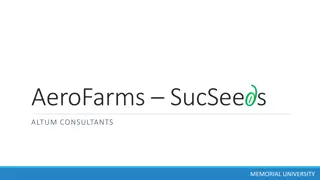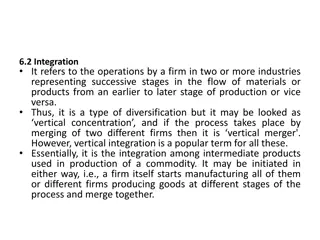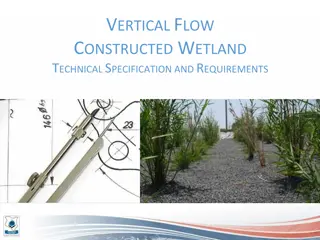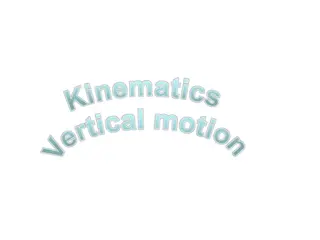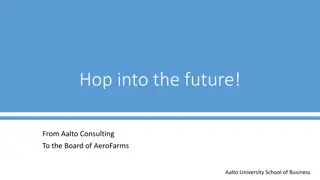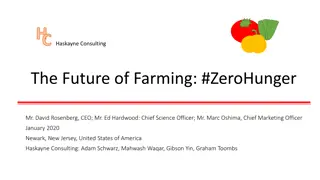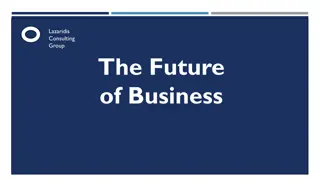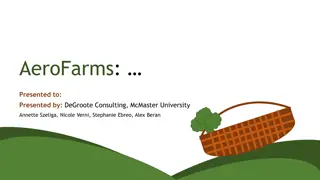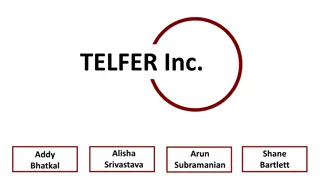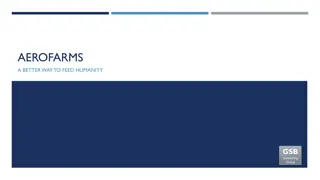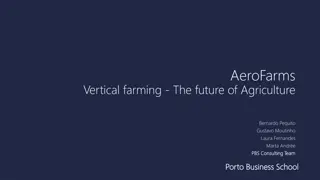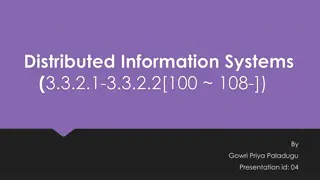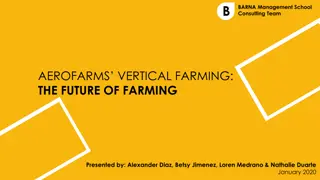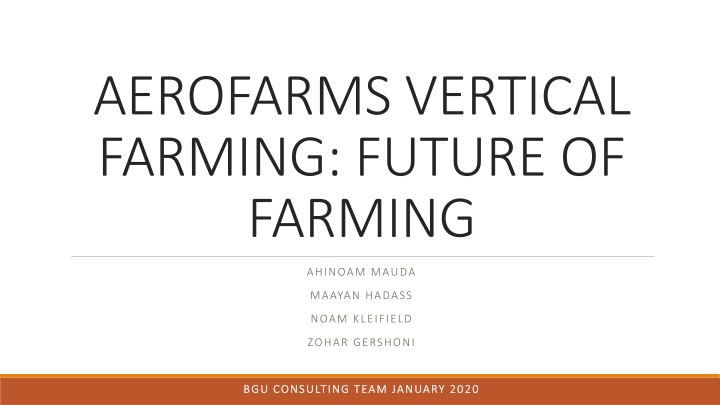
Aerofarms Vertical Farming: Shaping the Future of Agriculture
Aerofarms is revolutionizing agriculture with vertical farming to address global food crisis challenges, focusing on urban local and in-house farming. The mission is to enhance food security, reduce transportation costs, and provide fresh, locally produced crops. Key issues include profitability, sustainability, and capital requirements. Challenges such as carbon emissions and limited high-calorie grain production are being tackled. The analysis explores market value and implementation plans for Aerofarms' sustainable farming practices.
Download Presentation

Please find below an Image/Link to download the presentation.
The content on the website is provided AS IS for your information and personal use only. It may not be sold, licensed, or shared on other websites without obtaining consent from the author. If you encounter any issues during the download, it is possible that the publisher has removed the file from their server.
You are allowed to download the files provided on this website for personal or commercial use, subject to the condition that they are used lawfully. All files are the property of their respective owners.
The content on the website is provided AS IS for your information and personal use only. It may not be sold, licensed, or shared on other websites without obtaining consent from the author.
E N D
Presentation Transcript
AEROFARMS VERTICAL FARMING: FUTURE OF FARMING AHINOAM MAUDA MAAYAN HADASS NOAM KLEIFIELD ZOHAR GERSHONI BGU CONSULTING TEAM JANUARY 2020 BGU CONSULTING TEAM JANUARY 2020
The mission Resolve the global food crisis problem while contributing to food security through urban local & in-house farming
Projected vertical farming market globally (2013-2023) in US$ billions 2013 0.41 2016 1.5 2020 1.97 2023 6.4 0 1 2 3 4 5 6 7 Series 1
Value proposition Reduced transportation costs compering traditional agriculture Short product to market cycle: a few hours instead of a few days Fresh & locally produced crops Appreciated by consumers who are conscious of health & sustainability. & contributes to producing more food & faster
Problem definition Could AEROFARMS vertical farming be the future of crop cultivation while maintaining profitability and sustainability of the business model ? Problem Definition Analysis Implementation plan Key issues Alternatives Risks & mitigation
Key issues Profitability Substantiality Capital requirements Problem Definition Analysis Implementation plan Alternatives Risks & mitigation Key issues
challenges Producing more carbon emmissions No high calories grain production Problem Definition Analysis Implementation plan Key issues Alternatives Risks & mitigation
Market value of Vertical Farming ASIA PACIFIC NORTH AMERICA EUROPE REST OF THE WORLD 0 50 100 150 200 250 300 350 400 Implementation plan Problem Definition Analysis Key issues Alternatives Risks & mitigation
AEROFARMS sustainability characteristics Clothes (for holding roots) made from recycled water bottles (patent) that can be cleaned and reused Patents & trade secrets Ensure data safety Keeping expertise in-house 280 standards operating procedures Monitor crop: observe cultivation in real time Enables the company to stay sustainable and to improve the world food problem Analysis Problem Definition Implementation plan Key issues Alternatives Risks & mitigation
Market value predicted growing rate of Vertical Farming in the USA by 800 680 21.7% 700 21.4% 560 600 21.4% 26.4% 460 500 430 400 27.7% 340 21.7% 280 280 300 230 180 200 100 0 2019 2020 2021 Aquaponics Hydroponics Aeroponics
Competition 3 types of vertical farming Aeroponic Hydroponic Aquaponic AEROFARMS BOWERY FARMING INC PLENTY INC GOTHAM GREENS FARMS BRIGHTFARMS LUFA FARMS AEROFARMS is the only big & successful company in the Aeroponic technique Analysis Problem Definition Implementation plan Key issues Alternatives Risks & mitigation
AEROFARMS marketing partners Retailers the biggest costumers (US retailers -> SHOP RITE, WHOLE FOODS, SEABRA) Singapore Airlines farm-to-plain partnerships -> improving flight meals Partnerships with chefs-> restaurant supplier for healthy ingridients If AEROFARM wants to continue to grow and have more impact worldwide it needs to maintain existing partnerships & create more Analysis Problem Definition Implementation plan Key issues Alternatives Risks & mitigation
Decision matrix Market Rest of the world Europe North America Asia Pacific Business model Francis JV Full ownership Online sales technology Aeroponics Aquaponics Hydroponics Costumers B2B B2C
Decision matrix Market Rest of the world Europe North America Asia Pacific Business model Francis JV Full ownership Online sales technology Aeroponics Aquaponics Hydroponics Costumers B2B B2C
Alternatives 1 2 3 Full Franchise JV ownership
Alternative 1- Franchise Keep spreading by franchise model pros The owners are familiar with the market Distance controlling Risking brand s name by franchisers Less risk High spread High option of monitoring cons
Alternative 2- JV Keep spreading by joint venture model with existing farms pros Options to wide spread share the data High risk model The partners are familiar with the market The farms are located out of the cities cons
Alternative 3- Full ownership Keep spreading by full ownership model pros Model that you are familiar with Risky model Less spreading No share revenues cons
Decision matrix Market Rest of the world Europe North America Asia Pacific Business model Francis JV Full ownership Online sales technology Aeroponics Aquaponics Hydroponics Customers B2B B2C
Recommendation We recommend you to focus on expend your seals as first step, in order to stay the market leader and insure your profitability and substantiality, by adopt new business model in existing and new market. In the long term, we encourage you examine the option to expend your production to more product, according to the market demand.
Profitability Substantiality Implementation Plan Capital Requirements Business Model Markets Market Education Technology Implementation plan Problem Definition Analysis Key issues Alternatives Risks & mitigation
Profitability Substantiality Business Model Capital Requirements Franchise Online sales Implementation plan Problem Definition Analysis Key issues Alternatives Risks & mitigation
Profitability Substantiality Business Model- Franchise Capital Requirements Hire new franchise team Organization structure 5 workers Privacy contracts Protecting Copy rights Implementation plan Problem Definition Analysis Key issues Alternatives Risks & mitigation
Profitability Business Model- Franchise Year 1 Year 1 Substantiality Capital Requirements 9-12 month 0-6 month 6-9 month Locate franchisers Training in the US Build the branches Build training model Hiring employes Locate customers Implementation plan Problem Definition Analysis Key issues Alternatives Risks & mitigation
Profitability Substantiality Business Model- Online sales Capital Requirements Collaborate with American delivery company Planning distribution infrastructure Year 1 Building the website Year 2 Lunching the website Implementation plan Problem Definition Analysis Key issues Alternatives Risks & mitigation
Profitability Substantiality Markets Capital Requirements North America Asia Pacific Implementation plan Problem Definition Analysis Key issues Alternatives Risks & mitigation
Profitability Substantiality Markets Capital Requirements Year North America Asia Pacific 1 2 3 2 franchise 3 franchise 2 franchise 2 franchise 2 franchise 3 franchise 14 farms in 3 years 25 total Implementation plan Problem Definition Analysis Key issues Alternatives Risks & mitigation
Profitability Substantiality Technology Capital Requirements Short term Stay with Aeroponics R&D on Hydroponics Long term Examine the use of Hydroponics Implementation plan Problem Definition Analysis Key issues Alternatives Risks & mitigation
Profitability Substantiality Market Education Capital Requirements Campaigns in social media Locate new customers Implementation plan Problem Definition Analysis Key issues Alternatives Risks & mitigation
Profitability Market Education- Campaigns in social media Substantiality Capital Requirements Health awareness campaign Emphasizing your advantages No CARBON release 95% less water recycling Use Instagram profile healthy cooking AEROFARMS products Implementation plan Problem Definition Analysis Key issues Alternatives Risks & mitigation
Profitability Market Education- Locate new customers Substantiality Capital Requirements Food industry Restaurants Hotels Airlines Use your satisfied past clients! Implementation plan Problem Definition Analysis Key issues Alternatives Risks & mitigation
Long term product R&D Research other options for a verity of crops (grains) growth according to market demand Implementation plan Problem Definition Analysis Key issues Alternatives Risks & mitigation
Risk mitigation risk probability mitigation The company is not able to sell the franchise modal medium Marketing & network in relevant market & strengthen the brand Franchise model will bring a decrease in product quality medium Increase control by creating quality presiders Lack of trust by online consumers High Promotion model: discounts, sales & earning points
Time line Year 1 Year 2 Year 3 Business Model- franchise team Locate franchise Built training model Training in the US Online sales Building the website Planning distribution infrastructure Collaborate with American delivery company Lunching the site Technology R&D marketing
Capital expense- in 000s $ 20$ Built training model 50$ Built online web 1,000$ R&D TOTAL 1,070$
Operation expense precast- in 000s $ 5 new workers- 200$ per year Hire new franchise team 5,000$ Collaboration with delivery company 1,000$ marketing 500$ Online operation 6,700$ TOTAL
Profitability Substantiality Implementation Plan Capital Requirements Business Model Markets Market Education Technology Implementation plan Problem Definition Analysis Key issues Alternatives Risks & mitigation


